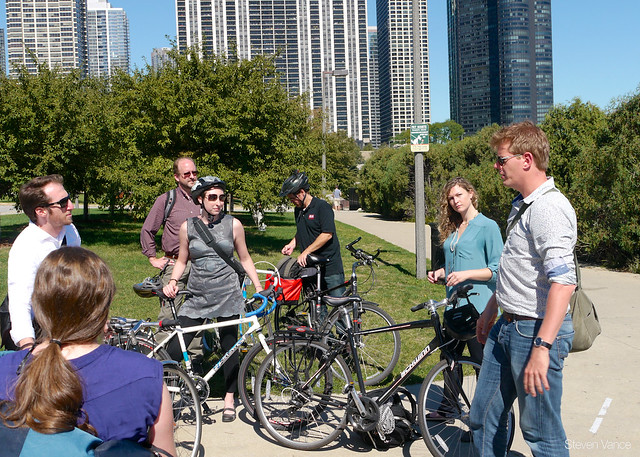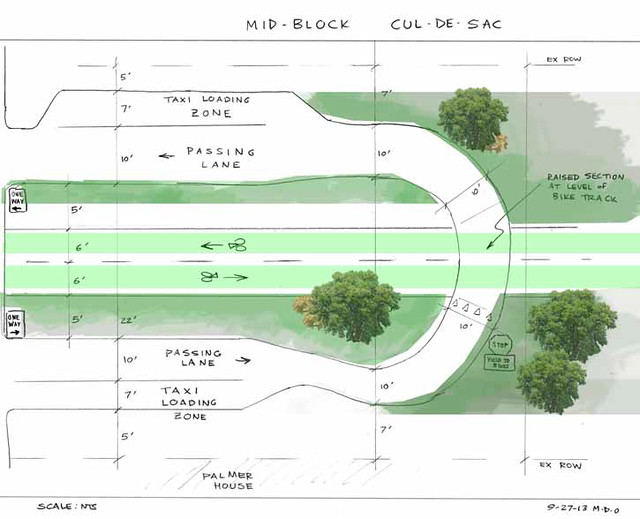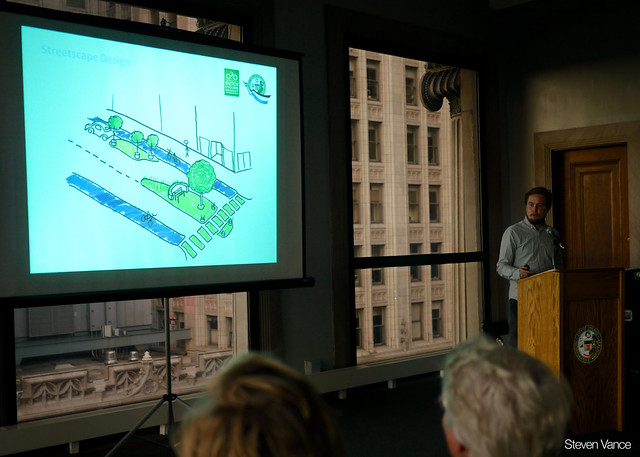ThinkBike Challenges Chicagoans to Think Beyond Bike Lanes
1:26 PM CDT on October 2, 2013
Last Thursday, Dutch "mobility advisor" Sjors van Duren stood by the Lakefront Trail, pointed to the block of Monroe Street between Columbus and Lake Shore Drive, and asked, "What is the function of this street?" The answer, it was agreed, is to distribute automobiles between the Loop and Lake Shore Drive. Van Duren works for the Arnhem Nijmegen City Region in the Netherlands, and he was brought to Chicago last week by the Dutch Cycling Embassy (a public/private program that aims to export Dutch cycling policies) to lead a group of local advocates, planners, engineers, and neighbors to find a way to make Monroe Street better for cycling between the Loop and Lakefront Trail.
Van Duren pointed out that Monroe near Lake Shore Drive is no different than Roosevelt, Balbo, Jackson, and Randolph. Why should there be five streets for driving to and from Lake Shore Drive but none that work especially well for biking or walking to the Lakefront Trail?
The real Dutch embassy sponsored ThinkBike to teach and inspire new ways of providing for cycling. At the public workshop on Thursday morning, the ThinkBike leaders said that getting more people to cycle is about more than bike lanes, or even safety for that matter. A good city for bicycling needs coherence, directness, attractiveness, and comfort, too. They achieve this in the Netherlands by making bikeways out of red asphalt, allowing bicyclists to travel in both directions on one-way streets, optimizing traffic lights for bike speeds, and other methods that help make cycling an easy transportation choice for most people. Additionally, they pay attention to details like shade and lighting, fixing potholes, and reducing the number of stops bicyclists need to make.
Chicago has started to implement designs like protected bike lanes and raised bike lanes, but "thinking Dutch" isn't the norm here yet. Ryan Lakes, a board member of West Town Bikes, worked with a ThinkBike group on Milwaukee Avenue between Division and North in Wicker Park. He told me his concerns "are about Chicago's resistance to truly effective designs because of the popularly held conceptions that protected bike lanes are almost already too much to ask for."
In 2010, the Dutch embassy sent over transportation experts to work on Lincoln Park streets and Clark Street in particular, as well as Madison/Washington through the Loop. The Madison/Washington work was used to develop bikeway plans in the Central Loop BRT project, Chicago Department of Transportation bike program manager Mike Amsden said. Protected bike lanes will be built eastbound on Washington and westbound on Randolph. Meanwhile, momentum has built to calm speeding traffic on Clark between North and Armitage, but nothing has changed yet.
On Friday, the two ThinkBike groups presented their ideas and design concepts to an audience at the Cultural Center after "suspending reality" for two days. The Monroe group reported that certain blocks are designed in ways that don't match how people use them. The block at the Art Institute's Modern Wing, for instance, is an access street and is used by people crossing between Millennium Park and the museum, and by taxis and tour buses dropping off passengers. Yet Monroe is five lanes wide here, and crosswalk rules are hardly respected.
The group presented their ideas about how to provide for cycling in the Loop, starting on Monroe as far west as Union Station. One proposed design diverted through traffic off some blocks but maintained taxi/loading access for businesses and the Palmer House hotel.
Marissa Dolin, a transportation planner at Active Transportation Alliance, participated in the Monroe group and told me that they tried to develop innovative street designs "to address everyone's interests." She also said "the city will need to consider tradeoffs for how to use available right of way and how those tradeoffs will affect the people that live, work, visit and own businesses in the area" and that the Monroe group's design ideas prioritized people on foot and bike "while still providing access for other modes."
The Milwaukee Avenue group based their proposals on the fact that the street is a destination for shopping and eating but is used as a through route for traffic. They proposed calming traffic by adding curbside bike lanes, removing car parking from alternating sides of the street, and using chicanes to slow traffic.
Lindsay Bayley, a Milwaukee group member, said, "We're going to need to get creative because space is so limited." She learned that on narrower streets like Milwaukee, the Dutch prefer to mix traffic while giving priority to pedestrians and bicyclists, rather than completely separating modes. "They start at a young age teaching everyone that safety means looking out for the vulnerable users." On one block, between Paulina and Wood Street, they proposed a shared street where only buses, bikes, taxis and people on foot would be allowed, similar to a proposal from a design class at the School of the Art Institute in 2011.
Michelle Stenzel was in the audience Friday evening. She knows a thing or two about Clark Street and told me she hopes the workshops inspire CDOT's complete streets team to "continue to think big in the future," acknowledging that they would face numerous hurdles in realizing these visions for Monroe and Milwaukee.
Stay in touch
Sign up for our free newsletter
More from Streetsblog Chicago
Today’s Headlines for Thursday, April 26
The de-facto ban on riverwalk biking is back. What should we do about it?
In the short term, new signage is needed to designate legal areas for cycling on the path. In the long term CDOT should build the proposed Wacker Drive protected bike lane.





